|
Contents:
|
But of course even before the beginning of specific, selective breeding by humans, development (evolution) of different dog populations took place. The dog has been man's companion for thousands of years and since then has developed without human intervention, quasi "by itself", by means of natural selection. However, there are only few breeds in which we can observe this development process concretely. The indigenous Japanese dogs belong to the rare breeds with a traceable development process. In their case we can look back on a development history of more than 2000 years.
 The Jomon dog as the common origin of the Japanese dogs
The Jomon dog as the common origin of the Japanese dogs
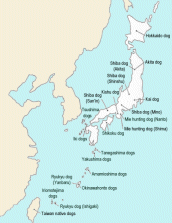 In Japan at least 17 indigenous dog breeds and populations exist (see map). As well as the well-known six breeds recognised by the FCI (Akita to Shikoku) a special mention must be given to the Ryukyu dog, called after its area of origin, the Ryukyu Islands south of the Japanese main islands. A special organisation, the Ryukyu Inu Preservation Society, in Japanese Ryukyu Inu Hozonkai, takes care of this breed. In addition there are special organisations for the Mikawa dog from the Tokushima prefecture and for the Satsuma dog from the Kagoshima prefecture which was already thought to have become extinct.
In Japan at least 17 indigenous dog breeds and populations exist (see map). As well as the well-known six breeds recognised by the FCI (Akita to Shikoku) a special mention must be given to the Ryukyu dog, called after its area of origin, the Ryukyu Islands south of the Japanese main islands. A special organisation, the Ryukyu Inu Preservation Society, in Japanese Ryukyu Inu Hozonkai, takes care of this breed. In addition there are special organisations for the Mikawa dog from the Tokushima prefecture and for the Satsuma dog from the Kagoshima prefecture which was already thought to have become extinct.
During the last decades Japanese researchers have systematically investigated the origins of the Japanese dogs. Several scientists have rendered outstanding services to this research. The pioneer of the newer canine research in Japan is without doubt Katuaki Ota from Nagano University who in 1980 submitted an extensive report to which Japanese scientists still refer. Unfortunately, this report was published only in Japanese, but at least there is a detailed English summary and also the statistical data are in English. [1]
Furthermore, the names of two men who lead several research teams must be pointed out. These are Yuichi Tanabe from Gifu University and Nobuo Shigehara from Kyoto University. In numerous publications both scientists have provided us with a solid foundation for our knowledge about the indigenous Japanese dogs.
Based on the gene analysis of more than 1.500 Japanese dogs Yuichi Tanabe was able to demonstrate when and on which ways the first dogs came from the Asiatic mainland to Japan. [2] According to his research the first dogs reached Japan in two immigration waves: once with the Jomon people from Southeast Asia via Taiwan and the Ryukyu Islands in the so-called Jomon Period (from 10.000 BC to 300 BC); and again with immigrants via the Korean Peninsula in the so-called Yayoi Period (from 300 BC to 300 AC) as well as in the Kofun Period (from 300 to 600 AC). The immigrated dogs from these three epochs of the early Japanese history are often classed together as Jomon dogs in the research. They intermingled with each other and, according to the findings of Prof. Tanabe and other researchers, form the single, common origin of all indigenous Japanese dogs.
Nobuo Shigehara has confirmed this assumption by means of new gene analyses. He examined the inherited material of 120 dogs from the early history of Japan (mostly bone remains from the Jomon Period up to the Kamakura Period in the 14th century) and of 124 contemporary Japanese and 54 non-Japanese dogs to ascertain their phylogenetic relationship. [3] The researchers on this project led by Prof. Shigehara arrived at the conclusion that the dogs from the Jomon Period form the basis of the current Japanese dogs. However, apparently after the Kamakura Period dogs from the neighbouring countries came to Japan and also contributed to the gene pool.
Yuiche Tanabe again has specified the contingent of this genetic material with respect to the modern Shiba. [4] He differentiates between the three Shiba variants San'in, Mino and Shinshu Shiba. Tanabe arrives at the conclusion that the San'in Shiba was genetically most strongly influenced by the hybridisation of the Jomon dogs with the dogs from the Yayoi and Kofun Period. The Mino Shiba and Shinshu Shiba, now to be found throughout Japan, were also clearly genetically influenced by the later dogs from the Yayoi and Kofun Period but not to such a large extent.
 The Shiba a direct descendant of the Jomon dog
The Shiba a direct descendant of the Jomon dog
What does the fact that the Shiba of today has been influenced by the Jomon dog from the early Japanese history really mean? Is this influence perceivable in the physical appearance, in the phenotype?
Thanks to many bone findings from excavations we have a very good image of the Jomon dog. According to a reconstruction the Jomon dog looked like this:
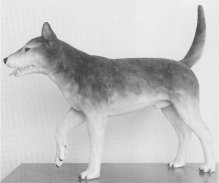
The Jomon dog had the following characteristics: (1) a stout body, (2) a shallow stop, (3) a narrow face, (4) a relatively wide muzzle. The Jomon dog's build has not changed for a long space of time. [5]
This appearance hardly reminds of the current Japanese breeds, solely the erect ears and the sickle tail were visible in the Jomon dog. Decisive however is another characteristic. The analysis of the findings of Jomon dogs delivered the anatomical insight that the historical Jomon dog had the size of today's Shiba. [6] The Jomon dog already had the same proportions as the modern Shiba. Only the head showed characteristic differences. A comparison of the skull of a Jomon dog and of a current Shiba makes this evident. On the left side you see the skull of a Jomon dog, on the right the skull of a contemporary Shiba:

Viewed from above there is hardly any difference recognisable for the non-professional. But in the side view the characteristic difference can be seen clearly: the Shiba has a more prominent stop, a shorter nasal bridge and shorter canine teeth (left Jomon dog, right Shiba):

The appearance of the Japanese dogs originating from the Jomon dog changed gradually, mainly due to natural selection. Very distinctive is the heightening of the stop which had begun already in dogs from the Yayoi Period (300 BC to 300 AC) and then continuously increased up to the Middle Ages (1200 to 1600). The following silhouettes demonstrate this development. They show the head of a Jomon dog (1), of a dog from the Middle Ages (2) and the head of a contemporary Shiba (3):

The development of the Japanese dogs was directed to a higher stop, a shorter muzzle and a broader face. Overall the Japanese dogs became larger – except for the Shiba. Of all current Japanese dogs the Shiba has retained the most morphological resemblance to the Jomon dog. Shigehara and other Japanese scientists are sure that the Shiba is a "direct descendant" of the Jomon dog. [7]
 The formation of the modern Shiba in the Edo Period (1603-1868)
The formation of the modern Shiba in the Edo Period (1603-1868)
The gradual changes that can be observed in the Japanese dogs up until modern times were not the result of breeding, but rather of natural selection. The Japanese researchers cite cultural reasons for this fact. At the end of the Jomon Period agriculture (rice cultivation) was introduced from the Asiatic mainland changing completely the people's lifestyle and the importance of dogs. Originally the Jomon dog had been an indispensable hunting companion to man. Due to the introduction of agriculture dogs lost this significance and were only needed as watch dogs. There were no efforts and no specific reasons to develop the Japanese dogs by breeding them. This is in keeping with – as Nobuo Shigehara says – the common Japanese attitude to accept nature as it is and not to modify it. Not until the beginning of modern times did this situation change.
In research the phase in which a breed arrives at its characteristic shape by means of selective breeding is called "breed formation". [8] In this context "selective" means intensifying required breed characteristics and eliminating unwanted traits. The classical time of breed formation in Japan (as well as in Europe) was from the 17th to the 19th century. In Japan this epoch is called the Edo Period.
The Edo Period is named after the new capital Edo, later Tokyo (previously Kyoto was the capital). This epoch, also known as Tokugawa Period, brought Japan the longest period of peace in its history and a special economic and cultural bloom. At the same time it was the period of Japan's total isolation from the outside world. Only representatives of the Chinese empire and of the Dutch East India Company were allowed to stay in Japan, all other foreigners were prosecuted and killed. Regarding the Japanese dogs this isolation implicated a just marginal hybridisation with foreign dogs.
Domestic and hunting dogs
The Edo Period did not only bring about cultural bloom but was characterised mainly by the fact that science, art and recreational leisure were no longer the privilege of the upper class but were accessible for everybody. For the first time something existed which today we would call "mass culture". This included dogs. Lap dogs became popular (see picture) and also ordinary people kept domestic dogs just for fun. In other words, an obvious demand for domestic dogs developed and this was accommodated by breeders.
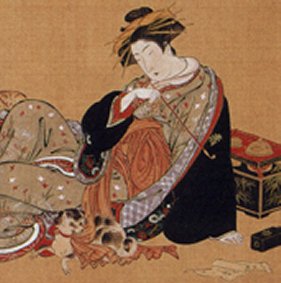 |
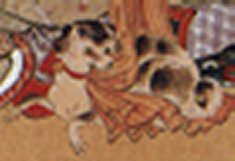 |
| Mizuno Rochô (1748-1836): Seated Courtesan with Dog. Early 1780's. | |
A second, far more important fact promoting dog breeding was completely independent of this tendency to domestic dogs. It was the spread of hunting in Japan that benefited especially the Shiba. [9] The Shiba was used for hunting wild birds, for which he was famous in two capacities: namely for flushing pheasants and other birds from the ground so that they took refuge on trees (ageki-ryo = "treeing"); then the ability to round up ducks at one place by barking loudly (yobiyose-ryo = "duck tolling"). Nowadays in Japan almost solely the Kishu is used for hunting wild boars, whereas in the past the Shiba was also an excellent and popular hunting dog.
It can be assumed that at the end of the Edo Period the Shiba had essentially adopted his present-day shape by means of breeding. In fact, on the famous pictures from this time, the ukiyo-e, dogs are shown to have the typical distinctive marks: prick ears, a highly borne, curly tail and the "foxy" facial expression. An example is the picture "An old priest chasing away a dog" by Onishi Chinnen (1792-1851):
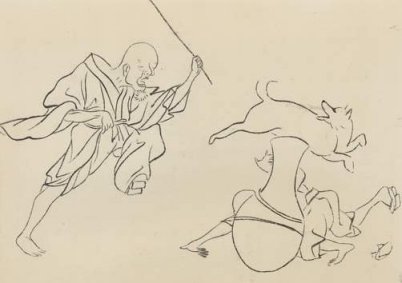
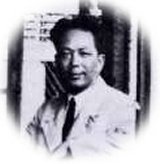 The phase of breed formation can be considered as completed when the breed regulations are fixed in a standard and recognised by one of the large canine associations. In case of the Shiba this would be the standard from 1935 which is based on the results of field researches by the famous group around Dr. Hiroshi Saito (picture). This group had in 1928 founded the "Preservation Society for Japanese Dogs" (Nihonken Hozonkai, NIPPO for short) and in 1934 released the first standard for the six Japanese breeds. Regarding the Shiba, Dr. Saito and his colleagues studied mainly dogs from the mountain areas, meaning Shibas which were used for hunting. In 1935 this standard was sent as the so-called NIPPO standard to canine associations all over the world. This standard was revised in 1987 and 1993 and has been binding for all Shiba breeders since then.
The phase of breed formation can be considered as completed when the breed regulations are fixed in a standard and recognised by one of the large canine associations. In case of the Shiba this would be the standard from 1935 which is based on the results of field researches by the famous group around Dr. Hiroshi Saito (picture). This group had in 1928 founded the "Preservation Society for Japanese Dogs" (Nihonken Hozonkai, NIPPO for short) and in 1934 released the first standard for the six Japanese breeds. Regarding the Shiba, Dr. Saito and his colleagues studied mainly dogs from the mountain areas, meaning Shibas which were used for hunting. In 1935 this standard was sent as the so-called NIPPO standard to canine associations all over the world. This standard was revised in 1987 and 1993 and has been binding for all Shiba breeders since then.
A comparison of the two versions of the standard reveals remarkable differences (see the reprint of the two standards on this website). The Nippo standard from 1935 was pretty lax regarding e.g. the shape of the tail or the admissible coat colours. In 1935 a curled or sickle-shaped tail was not yet a requirement; it could also be "straight" or short. With respect to the coat colours as many as 9 hues were allowed (dawn, white, wheaten, black, black and tan as well as four different grey tinges). Not until 1987 was this corrected to the present-day canon. With this, the phase of breed formation was finally completed, at a time when the first Shibas had long since been introduced to America and Europe. The image of the Shiba that we all have in mind today is still very new.
The so-called Jomon Shiba is not an ancestor of the Shiba. Quite the contrary, he is a contemporary, "artificial" brother bearing traits of the Japanese primal dog. The background is as follows.
In Japan, some decades ago fanciers split from the original NIPPO association and syndicated in the new "Preservation Society for the Shiba Dog", in Japanese "Shiba Inu Hozonkai" (SHIBAHO for short). Their ambition was to breed the contemporary Shiba to have more similarity to the historical Jomon dog again. For this reason they crossbred Shinshu Shibas with Shibas from the Akita prefecture. The new Shiba bred that way is now called Jomon Shiba, for some time it also was called Akita Shiba.
The Shibaho breeders are bothered by the "cute" appearance of the contemporary Shiba and want to restore his original, "wild" look. According to them the relatively high stop especially is responsible for this nice appearance. Therefore, by means of breeding the Jomon Shiba has been given a flatter stop, so to speak reversing the whole historical development to a prominent stop.
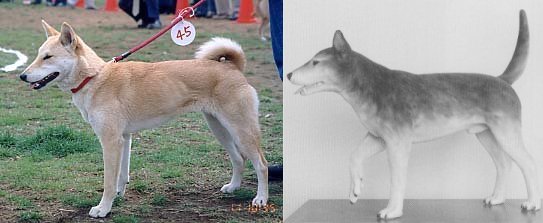
A comparison of the reconstructed Jomon dog with the newly created Jomon Shiba shows that the Shibaho breeders appear to have approached their ideal pretty well. However, the Jomon Shiba is not recognised as a distinct breed.
References
| [1] | Katuaki Ota: The dog, its domestication and development, with special reference to the origin of the native Japanese dog; and Morphological studies of Japanese native dogs, Report of the Society for Researches on Native Livestock 9 (1980), pp. 53-94 and 95-129; English summary pp. 232-237. |
| [2] |
Yuichi Tanabe: The origin of Japanese dogs and their association with Japanese people, Zoological Science 8, No. 4 (1991), pp. 639-651.
Y. Tanabe, K. Ota, S. Ito et al.: Biochemical-genetic relationships among Asian and European dogs and the ancestry of the Japanese native dog, Journal of Animal Breeding and Genetics 108 (1991), pp. 455-478. A German study discusses Tanabe's results in comparison with investigations by other researchers that have been published only in Japanese; see Ulrike Thiede: Auf Haustierspuren zu den Ursprüngen der Japaner. Vorgeschichtliche und frühgeschichtliche Haustierhaltung in Japan, München 1998, pp. 73-85. |
| [3] |
Naotaka Ishiguro, Naohiko Okumura, Akira Matsui, Nobuo Shigehara: Molecular Genetic Analysis of Ancient Japanese Dogs, in: Susan Janet Crockford (ed.), Dogs Through Time. An Archaeological Perspective. Proceedings of the 1st ICAZ Symposium on the History of the Domestic Dog. Eighth Congress of the International Council for Archaeozoology, Oxford 2000, pp. 287-292.
Naohiko Okumura, Naotaka Ishiguro, Masuo Nakano, Akira Matsui, Nobuo Shigehara, Toyohiko Nishimoto, Makoto Sahara: Variations in mitochondrial DNA of dogs from archaeological sites in Japan and neighbouring islands, Anthropological Science 107, No. 3 (1999), pp. 213-228. |
| [4] | Yuichi Tanabe: Genetic Evidence for the Routes Dogs Took to Japan, in: Michiko Chiba, Yuichi Tanabe, Takashi Tojo, Tsutomu Muraoka: Japanese Dogs. Akita, Shiba, and Other Breeds, Kodansha International, Tokyo, New York, London 2003, pp. 66-69. |
| [5] | Nobuo Shigehara: Morphological changes in Japanese ancient dogs, Archaeozoologia VI/2 (1994), pp. 79-94. |
| [6] | For details with respect to the individual body sizes of the Shiba and the Jomon dog see Nishinakagawa, H., Matsumoto, M., Otsuka, J., Kawaguchi, S.: Skeletal Remains of Domestic Dogs from Jomon and Yayoi Sites in Kagoshima Prefecture, Journal of the Anthropological Society of Nippon 100, no. 4 (1992), pp. 485-498. |
| [7] |
Nobuo Shigehara, Hitomi Hongo: Ancient remains of Jomon dogs from Neolithic sites in Japan, in Dogs Through Time [Refer. 3], pp. 61-67 (p. 65).
Nobuo Shigehara, Satoru Onodera, Moriharu Eto: Sex Determination by Discriminant Analysis and Evaluation of Non-metrical Traits in the Dog Skeleton, in: Susan J. Crockford: Osteometry of Makah and Coast Salish Dogs, Archaeology Press, Simon Fraser University, Burnaby, British Columbia, Canada, 1997, pp. 113-126. |
| [8] | A.-K. Sundqvist, S. Björnerfeldt, J. A. Leonard et. al.: Unequal contribution of sexes in the origin of dog breeds, Genetics 172 (2006), pp. 1121-1128. |
| [9] | Tsutomu Muraoka: Hunting and Japanese Dogs, in Japanese Dogs [Refer. 4], pp. 74-81. |